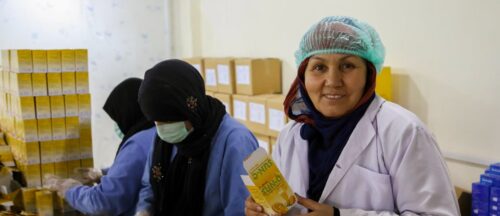Women’s economic empowerment to make the most of urbanization

By Lydia Lo, Research Analyst and Ammar Malik, Non-Resident Fellow at the Urban Institute, a partner in USAID’s Communications, Evidence and Learning (CEL) project.
Rapid urbanization creates a range of opportunities and barriers for women to achieve economic growth and prosperity. Cities may offer women greater access to training, paid employment, or capital for entrepreneurial ventures. However, cities can also be challenging environments if underlying gender biases that lead to double burdens (managing both a job and a household), inequitable legal barriers, or risks of gender-based violence are not addressed. Estimates indicate that global GDP could increase by as much as 26 percent if women’s participation in economic activities could be brought to par with men. So, what can governments and international actors do to help women take full advantage of the economic opportunities urbanization affords?
Read the full issue brief: Challenges and Opportunities for Urban Women’s Economic Empowerment
The White House and USAID’s Women’s Global Development and Prosperity initiative (W-GDP) offers a framework for action to enhance women’s participation in urban economies. The W-GDP is organized around three pillars to 1) improve women’s skills to secure quality jobs, 2) promote female entrepreneurship, and 3) remove legal, regulatory, and cultural barriers that prevent women’s economic participation.
Women in the workforce. The first pillar of the W-GDP aims to enhance women’s opportunities in the workforce by improving their skillsets.
Given low female education rates in the global South, most female employment in cities tends to be in the informal sector where workers have no legal protections but do have greater flexibility.
Enabling women to take full advantage of urban labor markets requires a two-track approach: 1) assist women in the informal sector in securing better-paid and protected jobs and 2) encourage more educated women to pursue technical training to access the higher-paying urban jobs within STEM fields. Some interventions that drive towards these goals include:
- Improving skill-building trainings through certification programs or worker cooperatives for informal workers to improve their formal employment options or bargaining power.
- Subsidizing women’s education in STEM fields through targeted programs raising awareness and providing an enabling environment.
Women as entrepreneurs. The W-GDP’s second pillar focuses on expanding female entrepreneurship. Cities can offer women business owners access to a greater talent pool of potential workers and a larger marketplace for acquiring inputs or selling outputs.
However, because of ownership and inheritance laws or norms, women worldwide are less likely to have access to capital needed to create and expand businesses since they are less likely to own land or property needed for collateral. Without funds necessary for investment or expansion, women’s businesses are more likely to exist in low-paying sectors that don’t require large up-front investment and stay small. Additionally, despite residing in cities, research shows that women’s social and professional networks are of lower quality than men’s networks. Faced with so many challenges, women entrepreneurs are particularly sensitive to improvements in the rule of law that protects their assets and reduces their risks of investment.
To encourage female entrepreneurship, organizations and governments might pursue:
- Creating new venture capital funds and platforms that introduce collateral-free, more risk-tolerant lending to help women grow businesses through internal investments.
- Organizing women-focused business networking events to expand their access to suppliers, business partners, and potential employees.
- Revising legal frameworks and make justice systems more equitable by targeting the removal of women-specific barriers and equitably enforcing rule of law.
Enabling women’s economic empowerment. To break down legal barriers to women’s economic participation, the W-GDP’s third pillar focuses on women’s ability to access institutions, build credit, manage property, travel freely, and work in the same sectors and jobs as men. In an urban context — beyond the strategies listed to improve female entrepreneurship — this requires policies that promote women’s physical safety, reduce their domestic responsibilities, and increase female representation in local governance.
Higher population density brings more job opportunities that increase the need for shared or reduced childcare burdens in families, but also more chances of sexual harassment or gender-based violence on the commute to work. While improved patrolling in transit systems could improve the status quo, governments must take on the harder task of addressing the roots of this violence by shifting social norms.
Strategies to clear legal, regulatory, and cultural barriers to women’s economic participation include:
- Introducing gender-neutral paid parental leave policies and offer improve childcare services so both women and men can choose to work.
- Designing programs for tackling public sexual harassment (e.g., through bystander interventions or public awareness campaigns).

